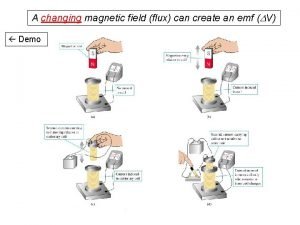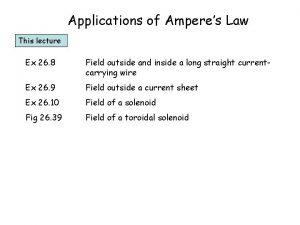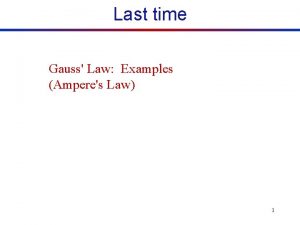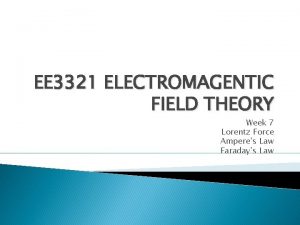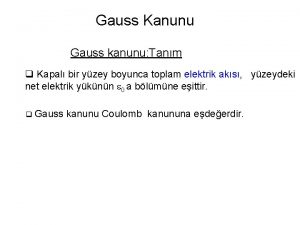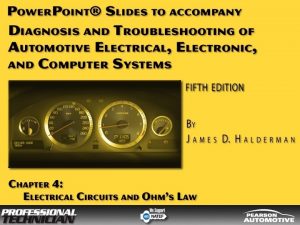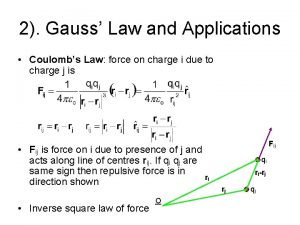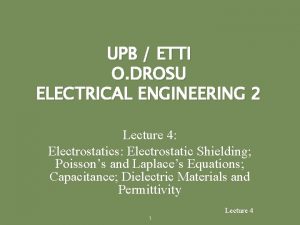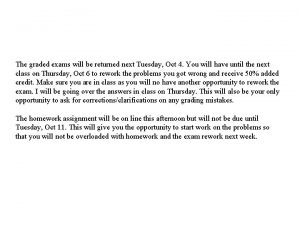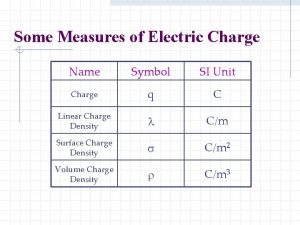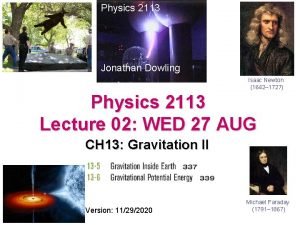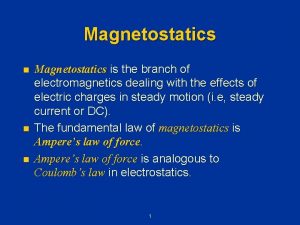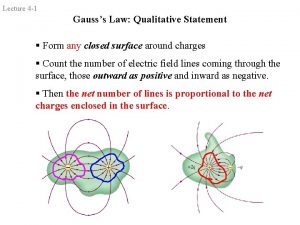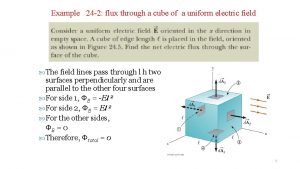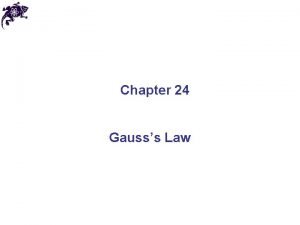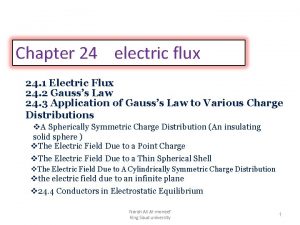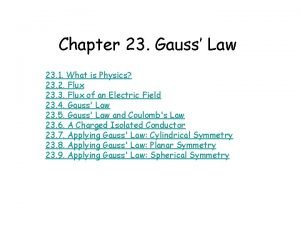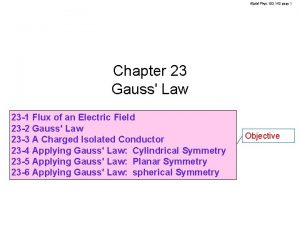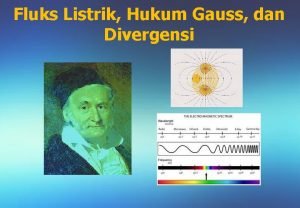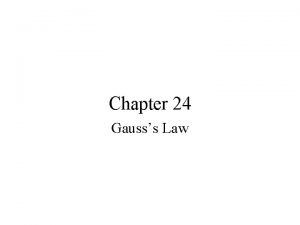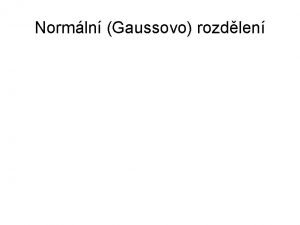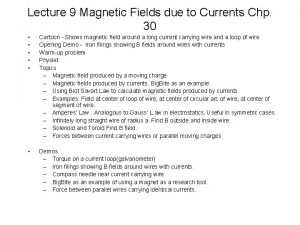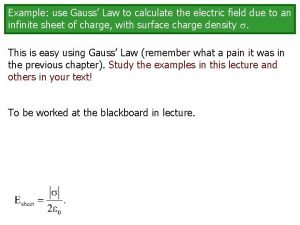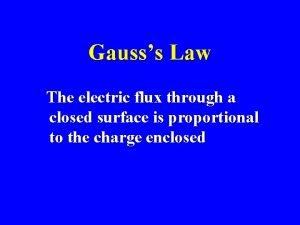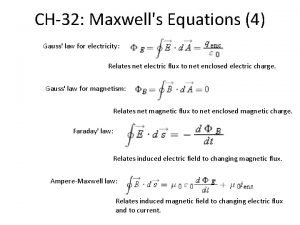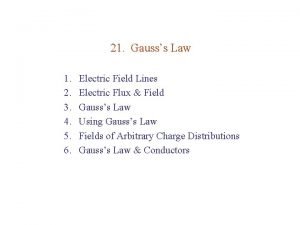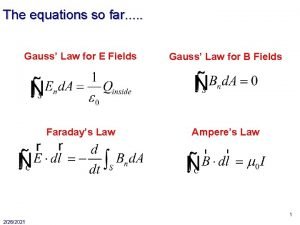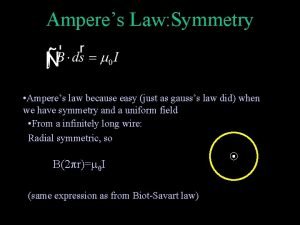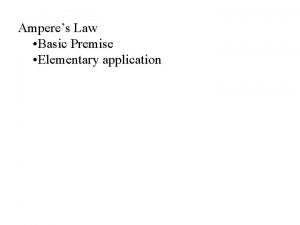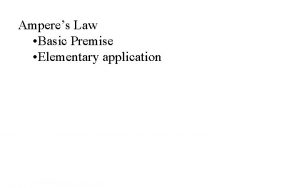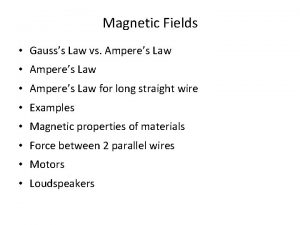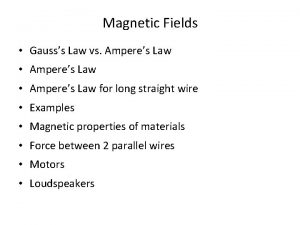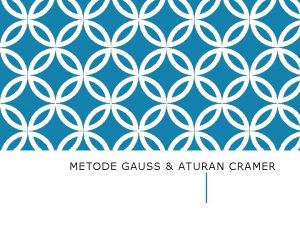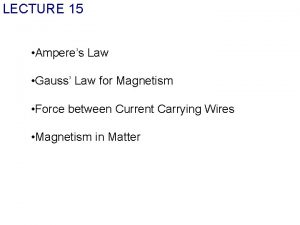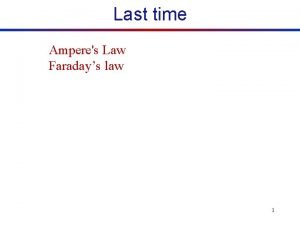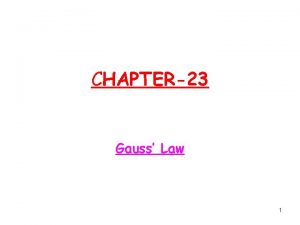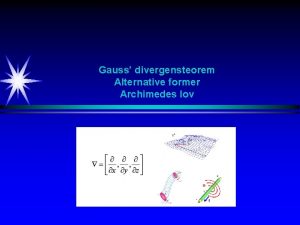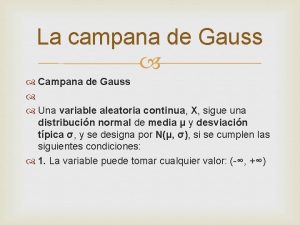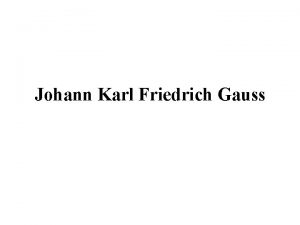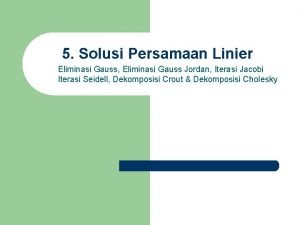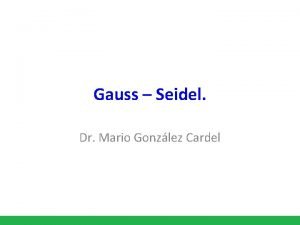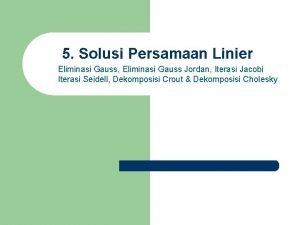Last time Gauss Law Examples Amperes Law 1































- Slides: 31

Last time Gauss' Law: Examples (Ampere's Law) 1

Ampere’s Law in Magnetostatics Biot-Savart’s Law can be used to derive another relation: Ampere’s Law The path integral of the dot product of magnetic field and unit vector along a closed loop, Amperian loop, is proportional to the net current encircled by the loop, • Choosing a direction of integration. • A current is positive if it flows along the RHR normal direction of the Amperian loop, as defined by the direction of integration. 2

i. Clicker question (last class) Use Ampere’s law to calculate the magnetic field inside a solenoid. (n is number of wraps per unite length). A. B. • Ampere’s Law: C. n windings per unit length D. 3

Today Ampere's Law Faraday’s law 4

Example: A Non-Uniform Current Distribution Long, hollow cylindrical current of current density: Insider the cylinder, the total current encircled by the Amperian loop is 5

Example: Magnetic field of a long wire outside the wire 6

i. Clicker Question outside the wire Assume uniform current density, what’s the magnetic field vs. r inside the long wire. A). C). B). D). 7

i. Clicker Question outside the wire inside the wire 8

Moving Bar and Energy Conservation P=I V=I(emf) Are we getting something for nothing? Bar – current I: FI F Fm Work: Power: x Main principle of electric generators: Mechanical power is converted to electric power a e P th s la t m o r f 9 s

Right now, can you answer the following questions? The magnetic field is decreasing, what’s the direction of the induced currents in the closed rectangular loop? A. Clockwise B. Counterclockwise C. No induced currents.

Faraday’s Law: Electromagnetic Induction • We have seen that an electric current produces a magnetic field. Ø Can magnetic fields produce electric currents? • An electric field is produced when there is a changing magnetic field. • In a closed electric circuit, that means current is generated due to the changing magnetic field. 11

approaching 6 D-04 Earth Magnetic Field Inductor moving away 12

Magnetic Flux 1 Wb = 1 T m 2 Gauss’s Law for Magnetism over closed surface (N turns)

Faraday’s Law Faraday’s law cannot be derived from the other fundamental principles we have studied Formal version of Faraday’s law: Sign: given by right hand rule Differential form of Faraday’s law: Michael Faraday (1791 - 1867)

Two Ways to Produce Changing Two ways to produce curly electric field: 1. Changing B 2. Changing A

Inductor Radio (6 D-15) 16

UHF Transmitter and Dipole Receiver (6 D-17) 17

Faraday’s Law and Motional EMF ‘Magnetic force’ approach: I Use Faraday law: I

Faraday’s Law and Generator I

Exercise A uniform time-independent magnetic field B=3 T points 30 o to the normal of the rectangular loop. The loop moves at constant speed v 1. What is the emf? 2. In 0. 1 s the loop is stretched to be 0. 12 m by 0. 22 m. What is average emf during this time?

Example R L B 1 Lv t I v B 2

Faraday’s Law of Induction (More Quantitative) The magnitude of the induced EMF in conducting loop is equal to the rate at which the magnetic flux through the surface spanned by the loop changes with time. N where Minus sign indicates the sense of EMF: Lenz’s Law • Decide on which way n goes Fixes sign of B • RHR determines the positive direction for EMF N

How to use Faraday’s law to determine the induced current direction 1. define the direction of ; can be any of the two normal direction, e. g. point to right 2. determine the sign of Φ. Here Φ>0 N 3. determine the sign of ∆Φ. Here ∆Φ >0 4. determine the sign of using faraday’s law. Here <0 5. RHR determines the positive direction for EMF • If >0, current follow the direction of the curled fingers. • If <0, current goes to the opposite direction of the curled fingers.

Conducting Loop in a Changing Magnetic Field Induced EMF has a direction such that it opposes the change in magnetic flux that produced it. approaching Ø Magnetic moment created by induced currrent I repels the bar magnet. Force on ring is repulsive. moving away Ø Magnetic moment created by induced currrent I attracts the bar magnet. Force on ring is attractive.

Induced Electric Field from Faraday’s Law • EMF is work done per unit charge: • If work is done on charge q, electric field E must be present: Rewrite Faraday’s Law in terms of induced electric field: This form relates E and B! • Note that for E fields generated by charges at rest (electrostatics) since this would correspond to the potential difference between a point and itself. => Static E is conservative. • The induced E by magnetic flux changes is non-conservative.

i. Clicker Question The magnetic field is decreasing, what’s the direction of the induced currents in the closed rectangular loop? A. Clockwise B. Counterclockwise C. No induced currents.

6 D-11 Jumping Ring Is there any differences in the two rings ? Why one can jump up, the other can’t ? http: //www. youtube. com/watch? v= ZL 4 kb. BIf 39 s 27

i. Clicker Question The magnetic field is fixed, what’s the direction of the induced currents in the closed rectangular loop? A. Clockwise B. Counterclockwise C. No induced currents.

Example Ø At 1, 3, and 5, B is not changing. Ø At 4, B in decreasing So there is no induced emf. into page. So current is Ø At 2, is increasing into page. So clockwise. B emf is induced to produce a counterclockwise current.

i. Clicker Question A current directed toward the top of the page and a rectangular loop of wire lie in the plane of the page. Both are held in place by an external force. If the current I is decreasing, what is the direction of the magnetic force on the left edge of the loop? a. Toward the right b. Toward the left c. Toward top of page d. Toward bottom of page e. No force acts on it. I

i. Clicker Question A current directed toward the top of the page and a circular loop of wire lie in the plane of the page. If a clockwise current is induced in the loop by the current I, what can you conclude about it? I a. I is increasing b. I is decreasing c. I remains constant d. I is discontinuous e. Nothing can be said.
 Amperes maxwell law
Amperes maxwell law Ampere
Ampere Are we getting
Are we getting Amperes law
Amperes law Differential form of ampere's law
Differential form of ampere's law Gauss vs gauss jordan
Gauss vs gauss jordan Kürenin alanı
Kürenin alanı If an insulated wire rubbed through
If an insulated wire rubbed through Gauss law vector form
Gauss law vector form Coulombs law
Coulombs law Differential form of gauss law
Differential form of gauss law Gauss law in dielectrics
Gauss law in dielectrics Surface charge density symbol name
Surface charge density symbol name Gauss theorem
Gauss theorem Differential form of gauss’s law in magneto statics is
Differential form of gauss’s law in magneto statics is Statement of gauss law
Statement of gauss law Gauss law cube example
Gauss law cube example Electrostatic equilibrium
Electrostatic equilibrium Electric field inside sphere
Electric field inside sphere Applying gauss law cylindrical symmetry
Applying gauss law cylindrical symmetry 102 cube
102 cube Materi fluks listrik
Materi fluks listrik Gauss law introduction
Gauss law introduction Gauss law
Gauss law Gauss law problems
Gauss law problems Gauss law
Gauss law Physics gauss law
Physics gauss law Gausss law
Gausss law Ampere maxwell law
Ampere maxwell law Gauss' law
Gauss' law Gauss law of magnetism
Gauss law of magnetism Gauss law
Gauss law
